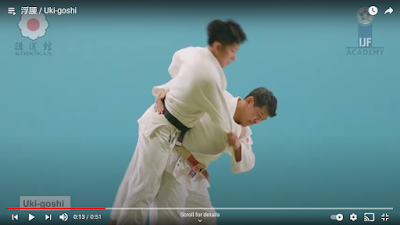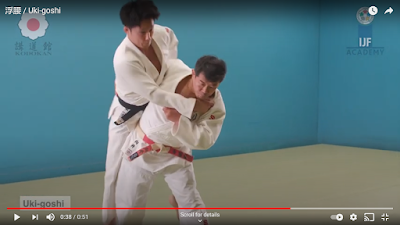Uki-Goshi: Everybody's Judo Throw
See also Uki Goshi - The Quintessential Judo ThrowUki-Goshi truly is everybody's Judo throw. Whilst it was not the first throw I learn, it is the first throw that most people learn nowadays. Even I teach it as the first throw to all my new students.
 |
| Stand Tall: Respect and Affect Click Here For More Information |
It is easy to teach, easy to do and can even be done from the ground by adults (Fig.1) and children (Fig.2), so it is "safe" (or as safe as anything can be in Judo) for beginners. More than that it is the ideal Judo throw because it doesn't matter what the size of your opponent compared to you, as long as you catch them off guard, you can throw them with Uki-Goshi. But that doesn't mean that it is easy to master. Even some very experienced Judoka don't realise that they are doing it wrong.
Practice throwing From the ground (Fig.1)
Practice throwing From the ground (Fig.2)
Here are some of the more common things Students do wrong:- Failing to turn your eyes and head in the direction you are throwing
- Failing to break Uke's balance as you enter the throw.
This is the most important thing. - Don't grab hold of the belt when you are doing the throw
- Don't use your hip-hugging arm to complete the throw
- Using strength to complete the throw doesn't help.
Notice in the picture below(Fig.3) how Tori is looking forward and down, in the direction that he is about to throw. Failing to do this creates significant hindrances to the throwing movement and interferes with your momentum.
 |
| (Fig.3) Judoka Looking Where To Throw |
Notice how in the picture below (Fig.4), Uke is standing on his toes and is being drawn forward.
 |
| (Fig.4) Tori Breaking Uke's Balance |
Failing to break Uke's balance will, if your opponent has any kind of experience at all, result in your throw being blocked.
Many players grab hold of Uke's belt when they doing this throw. Whilst it can be argued, that this does not affect the throw, it does at the very least, potentially change the throw to Tsuri-Goshi as it easily changes the Kuzushi of the Uke-Goshi. To avoid this is simple. Don't grab hold of Uke's belt. (Fig.5)
 |
| (Fig.5) Tori Has a Flat Hand on Uke's Belt & is Not Grabbing it |
You don't need to grab hold of Uke's belt in order to complete the throw and if you do, you are probably not doing Uke-Goshi.
It is a temptation for all judo practitioners, particularly beginners is to use the arm that is used to hug Uke to your hip, to push Uke over your hip to try to complete the throw. This is completely wrong. There is no gentler way to say it. As soon as your hugging arm is used to push Uke, you to change the direction of your momentum. Thus if you push you are effectively reversing the whole of your setup.
I believe the faulty thinking goes like this, your pulling arm, the one that has your hand gripping the Uke's sleeve, is dragging Uke around and it feels like you should push with your hugging arm in order to assist that. But remember your basic physics: "Every action has an equal and opposite reaction". Remember also that you are pushing against Uke's hip which is firmly planted on your hips. Thus when you push with your hip-hugging arm, your release some of your grip that is holding Uke in place and some of the reaction takes away from the movement of the arm that is pulling as well as from the rotation of your body.
In other words, it is very hard to pull and twist your body when you are also pushing, causing a reaction in the other direction to your pulling arm.
Besides, your hugging arm should be so far behind your back pushing with it should be next to impossible. The whole point of the hugging arm is to do nothing else but HUG. It is intended to hold Uke in so firmly they cannot avoid being dragged onto Tori's hip and held there until the throw is almost complete and it is no longer possible to hold the hip. The tighter the hug the more efficient the throw.
You should hug as hard as you can and allow your hugging arm to move with the rest of your body when it rotates to complete the throw.
This may seem a little counter-intuitive but if you practice it then it works.
Uki-Goshi is a momentum throw. It is dependant on your ability to draw Uke off balance and continue that action until Uke goes to the ground. Though most Tori's do, Tori doesn't even have to lift Uke off the ground. There is no strength required.
Your hip should be a pivot point, placed just below Uke's hips and aligned, as much as possible into the centerline of Uke (Fig.6). Your hip-hugging arm secures Uke's hip firmly (like a vice as much as you can) in place (Fig.5 above) and your sleeve holding hand pulls Uke down and around in front of your body (Fig.7), providing the forward momentum, as your whole body rotates (see more on the whole body rotation below). |
| (Fig.6) Correct Hip Position For Uki Goshi |
 |
| (Fig.7) Pulling Uke's Sleeve |
Whole-body rotation
This rotation is best observed in the first video starting at 31 seconds through 33 seconds.Not lifting
Pay careful attention to the video and note that Tori does not lift with his legs to complete the throw. Lifting of Uke is often seen in demonstrations of Uki-Goshi. Despite commonly held belief, it is incidental, not required for execution. Convincing some Judoka of this is sometimes difficult but I promise you, if you practice Uki-Goshi without lifting your partner with your legs at the end, your throw will improve.
What is the Difference Between Uke-Goshi and O-Goshi
It is often problematic when teaching Uki-Goshi to help students see the difference between Uke-Goshi and O-Goshi, as many cannot at first see it. But Uke-Goshi is NOT O-Goshi and learning the differences is important.
This is the way I try to explain the differences between students:"Uke Goshi is a hip glance, O-Goshi goes over the hip"
That is Tori's hip is placed close to the centreline between Uke's hips and below Uke's belt (Fig. 6 above). Whereas they are with O-Goshi (O-Goshi Fig. 4). Tori's hips are placed between Uke's hips or further past Uke.
Because of this, there is much more rotation around Tori with Uki-Goshi (watch the video closely) as Tori throws, whereas, for O-Goshi, Uke goes much more OVER Tori's hips. Hence, theoretically, if you catch your opponent off guard, anybody of any size could throw anybody else of any size with Uke Goshi, as there is no lifting involved. It is a pure twisting throw.
Stepping Forward
There is a version of this throw that is sometimes very helpful to Tori, where he steps forward and around at the end to complete it. This allows for even more rotation of the hips and is excellent for those who have difficulty getting enough rotation in order to complete the throw.
Tori Stepping Forward At The End of The Throw (Fig.8)
45 deg or on hip
There is a variation of Uki-Goshi that I should mention. The angle at which Tori places their hugging arm.
When I was first taught both Uki Goshi and O Goshi, I was taught to position my hugging arm at about 45 deg up Uke's back towards the shoulder (Fig.9). This works great but as you can see from the video not everybody does it.
 |
| (Fig.9) Hand Up Back 45 Deg Uki-Goshi |
I have no idea which is better. Physics would suggest that the higher grip is more in line with a fulcrum lever effect which is what both Uki-Goshi and O-Goshi are composed of. Certainly, it helps some players to learn the throws.
However, in competition whatever grip you can get is going to be best as long as it helps complete the throw. So practically it is neither here nor there if you do it or not. But if it helps you to learn Uki-Goshi by doing this you should do it.
The Mercury video (the second one)
I need to should also note that is in the Mercury video (the second one) there is a bend on Tori's part as he enters the setup for the throw. This is not a fault but used to be taught to allow a deeper entry with the hugging arm.
I have to say there is no question that if you can arch into Uke to do Uki-Goshi you will get a better throw and traditionally it is the way this throw was taught (look up any video of professor Kano teaching Uki-Goshi Fig.11). The problem is, that the arching back opens Tori to being blocked by Uke with their hand and thus the throw is countered. So the first video, where Tori draws Uke on to Tori's hip is the version most often taught today.
Uke Blocking Tori's Uki-Goshi With Their Hand
When Tori Arches To Enters The Thow (Fig.10)
Professor Kano Teaching Uki-Goshi Throw by arching (Fig.11)
Uki-Goshi is a foundational throw of Judo for several reason:
- It was said to be Professor Kano's Favourite throw
- It is the reason we have Harai-Goshi
Legend has it that Professor Kano developed Harai-Goshi to stop Saigo Shiro, one of his early foudatinal Kodakan Members, from defeating Uki-Goshi by stepping it around it.- It is the reason we have Tsuri-Komi-Goshi
Legend has it that Professor Kano developed Tsuri-Komi-Goshi to stop Saigo Shiro from defeating Harai-Goshi by proping to block the throw.- The above three throws, Uki-Goshi, Harai-Goshi, Tsuri-Komi-Goshi, form the second set of Professor Kano's Nege-No-Kata, the Kata that ever black belt is required to know and is one of those rare occations where we acctually thing we know the rational as to why they were included in that kata
Uki-Goshi is an incredible usefulness throw and every Judoka should make time to be as familiar with it as they can. even if it is not your favourite throw.
 Random thought on Life, Judo Olympics, Judo Self Defense, The Art or Judo Kata, Judo An International Sport. Things that inspire or annoy me or things that I just had to write down.
Random thought on Life, Judo Olympics, Judo Self Defense, The Art or Judo Kata, Judo An International Sport. Things that inspire or annoy me or things that I just had to write down.

No comments:
Post a Comment